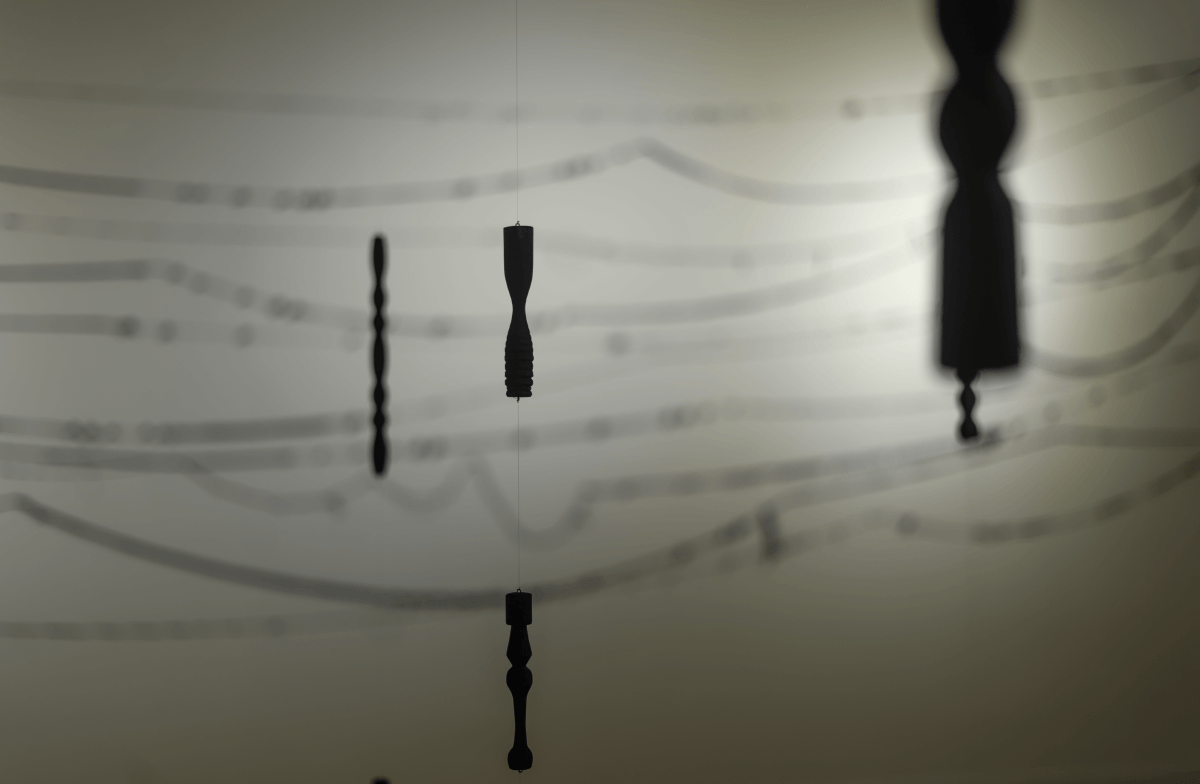Opening
Thursday 9 may 2024
7:30pm
9 May – 31 August 2024
Av. Pedro de Osma 409, Barranco
Lima, Peru
Free Admission
Hours
Wednesday – Saturdays
3pm - 8pm
proyectoamil
Lima
proyectoamil is pleased to present the first exhibition in Lima by Mexican artist Rogelio Sosa. This exhibition, entitled Constelaciones hápticas (Haptic Constellations), shows the results of the artist's month and a half long residency in Lima. Rogelio has produced four works especially for our new space in Barranco.
In this exhibition, there is a simple yet bold intention of transfer: to convert what touch perceives into sound. Against the grain of the academic tradition of graphic musical notation, Rogelio Sosa explores another form of haptic notation that seeks to investigate the perceptions produced by objects (living energies) on the most extensive organ we possess: the skin.
This proposition is not (only) a diversion or a mere departure from the canon in search of novelty, so dear to the art system, but rather an emphatic divergent, anti-hegemonic stance in an era—the cyborg-telematic—that privileges the retinal.
This visual axiom has programmed us to believe that we attend to the world to watch its evolution, that we go to a gallery or an exhibition to observe, undervaluing all the other multiple perceptual forms we possess. Those blank spaces—falsely neutral—serve as a place where objects enter (aseptically) into our bodies through sight: the gallery is the parallel of the page, ready to receive the logos in its foolish romance with ink. Both systems of exhibition and transmission of knowledge are an inversion of one of the oldest forms of writing: the stars in the sky; to constellate has always been to write, to make of the cosmos a myth to pass it through time.
In the manner of ancient stories and immemorial myths, Rogelio's invention-scores privilege the inaccurate over the precise data, that is, they also contravene the necessary determination and efficiency that the capitalist world-system requires to achieve its mercantile flows. This denial of the exact induces a high degree of creative freedom to the performer, who with their voice translates into sound what their fingertips and palms feel: textures, roughnesses, volumes, topographies, similarities, differences.
The four material forms that become scores stem from Rogelio's encounter in Peru a few years ago with the quipus; now, after distilling the fascination, he proposes an abjection of the object and its principle: beyond understanding them as a mnemonic system of notation and counting, Rogelio finds in them a possibility of ambiguous writing.
The knots, woods, ceramics, reliefs, and other objects do not intend to preserve "exactness," but to become a provocation for the creative interpretation of a system that explores the interstices and folds between dualities to expand—as a metaphor—the infinite spectrum of grays between two voids.
These improvisation structure-constellations require sharpening
feeling
thinking
emitting
So that touch affects the symbiotic body of the interpreter, who in turn reacts by inhaling-toning, reacting-sounding.
The four object-systems have in common their blackness. Although this quality is not absolute (we can see them offering punctual reflections in space, or brown and earthy tones), it intends to assert itself as another negation of dominant visibility: they desire their absence, or to be a veil rather than an image-matter. It is worth repeating: they ask to be felt with touch so that their subtle nuances provoke a mutual encounter: matter touches and allows itself to be touched.
That invitation to touch them is consistent with an ethic of making that for Rogelio is of seminal importance: his work involved modeling clay that was not commissioned to an artisan—there is no symbolic or material exploitation. The earth comes from Valle de Bravo, where he has lived for years, endeavoring to weave lasting relationships with his surroundings. The same happens with the embossed sheets and turned woods that emerge from the work of his hands—through tools, clearly.
This making consciously decides to modify certain materialities that have an organic affiliation such as wood, or clay, or textiles: they maintain a close relationship with a territory that is venerated and from which care is taken not to fall into extractivism. Elemental materials offer a superlative malleability and allow "to combine the haptic experience of manufacturing with the organization of composition and silence in time," in Rogelio's words.
With this set of works, the denial of another profuse tendency is also proposed, almost an idolatry: our time's fondness for smoothness, for everything that does not present roughnesses or differences. Let's think about how many times we have caressed the pristine screen of the phone and how many times the rough bark of an alder, or a carob. Let's think about skin depilation, about the Botox we inject to eliminate roughness, about most of Jeff Koons or Anish Kapoor's sculptures...
Rogelio Sosa's score forms are sustained in opposition-tension with smoothness; they feed on discontinuities, on the strange, on the negativity of the crinkled. They are useful, precisely, because they refute that emptiness (silence) of smoothness. To accommodate negativity is to accept the complexity of the mysteries that recreate existence.
It is worth reconsidering, to conclude, the scores not as utilitarian objects but as beings that modify us. Elvira Espejo has said about the act of spinning and weaving:
"...one watches how the fingers feel; one listens to your body how it receives and hears the song of the fingers; one allows the fingers to feed on the textures in order to identify things [...] Feeling the textures, the smell of the wool, the thinking of the whole set of actions enables multidisciplinary learning that allows you to feel that the spinning wheel is not only an instrument but a living being that inspires you and guides you, to bring a thread of life to the loom."
Those same principles are, here, put into play. Each interpreter holds a conversation from their subjectivity with the other beings they touch and that modify them. Or, speculating further, it serves to ask ourselves where we end, why do we consider our skin as what separates us from the world? What are we if not an incessant relationship?
For centuries, modernity shapes life with closed systems governed by rational conceptions; in the breakdown of such, there is a possibility of spillage, another way of transiting this dark time.
Mauricio Marcin
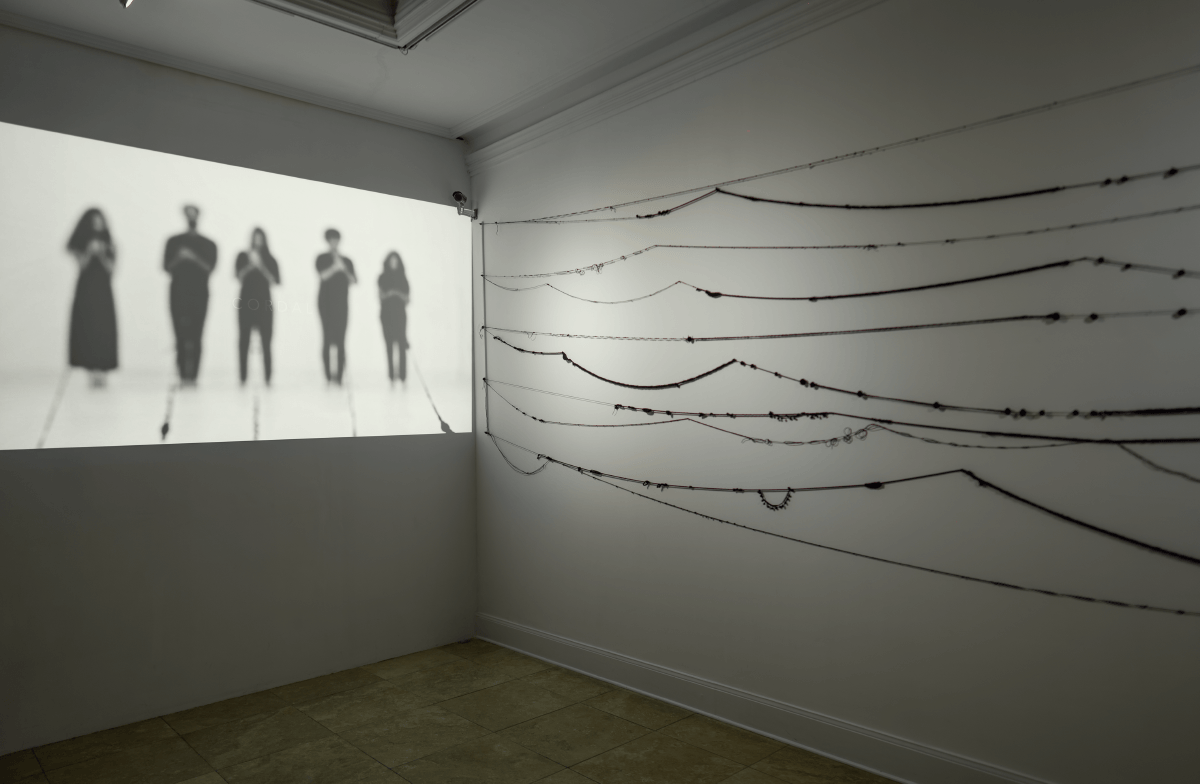
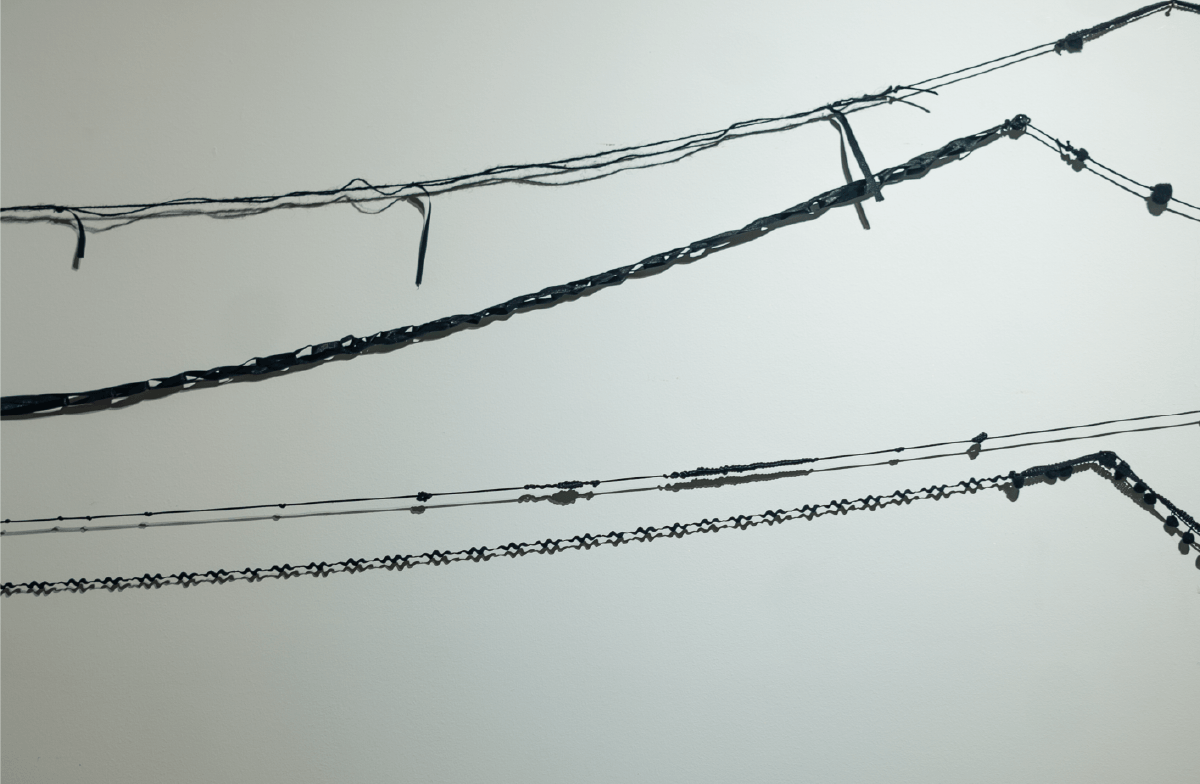
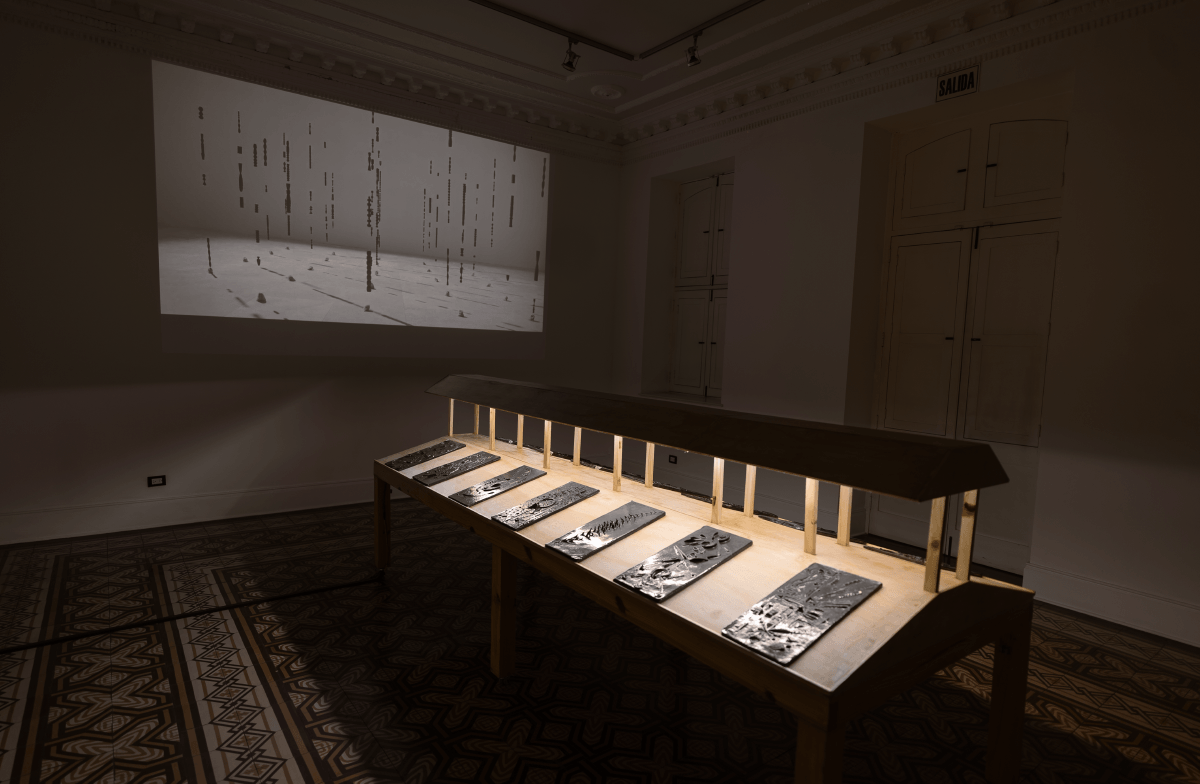
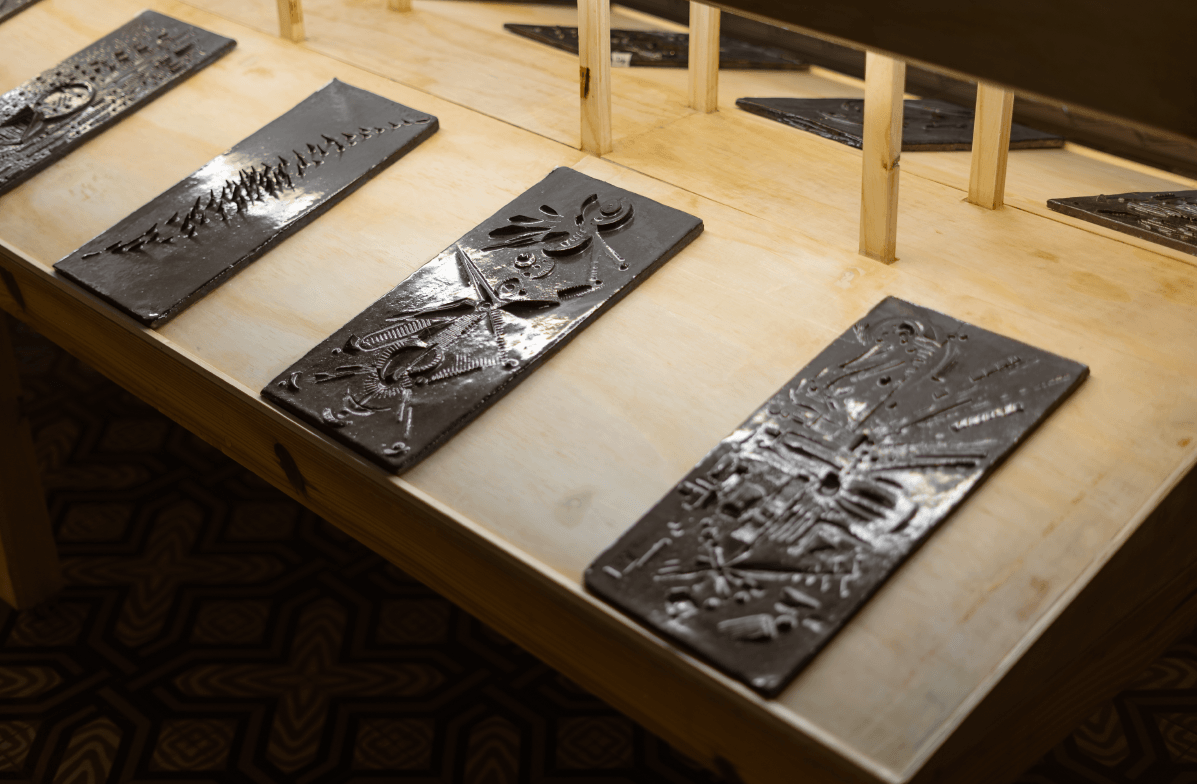
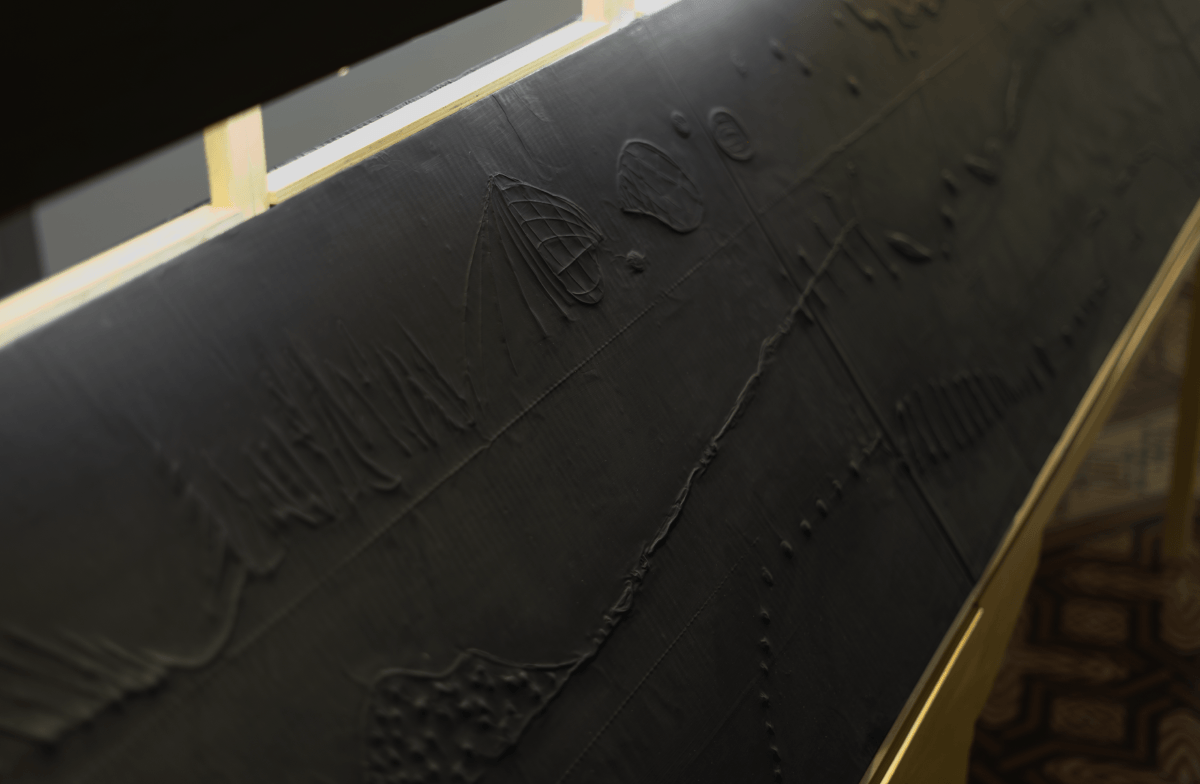
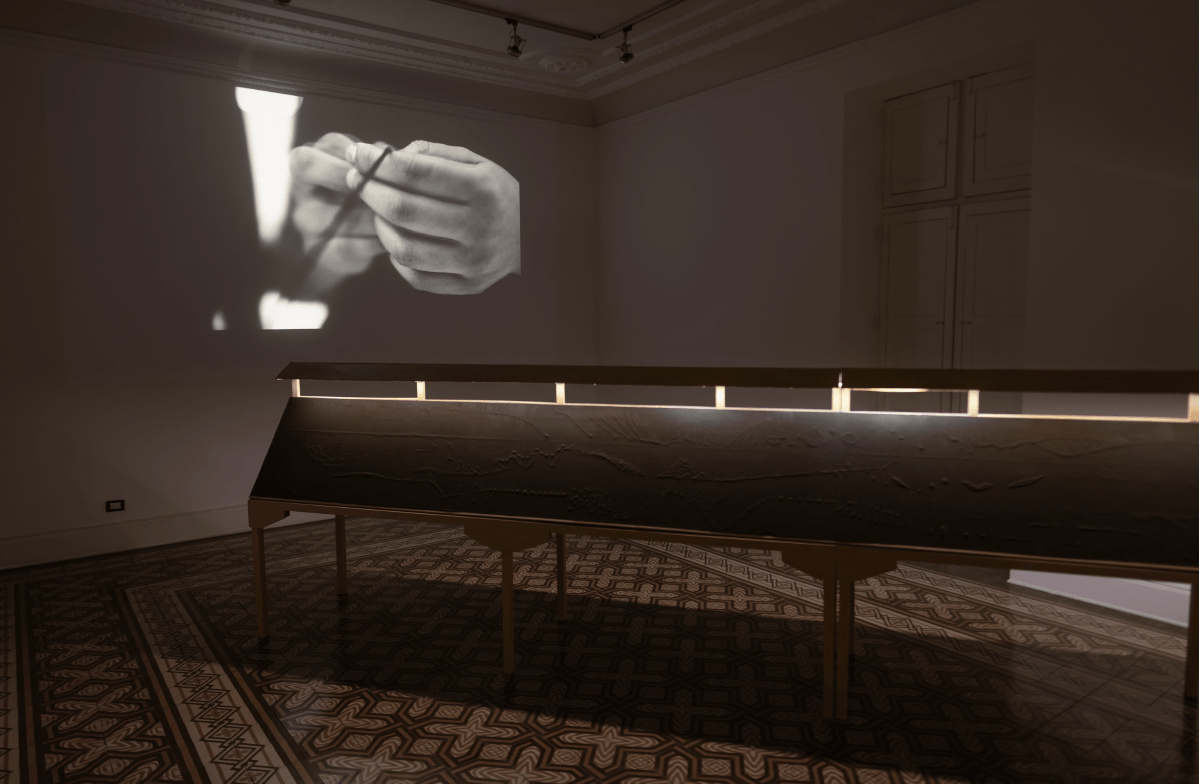
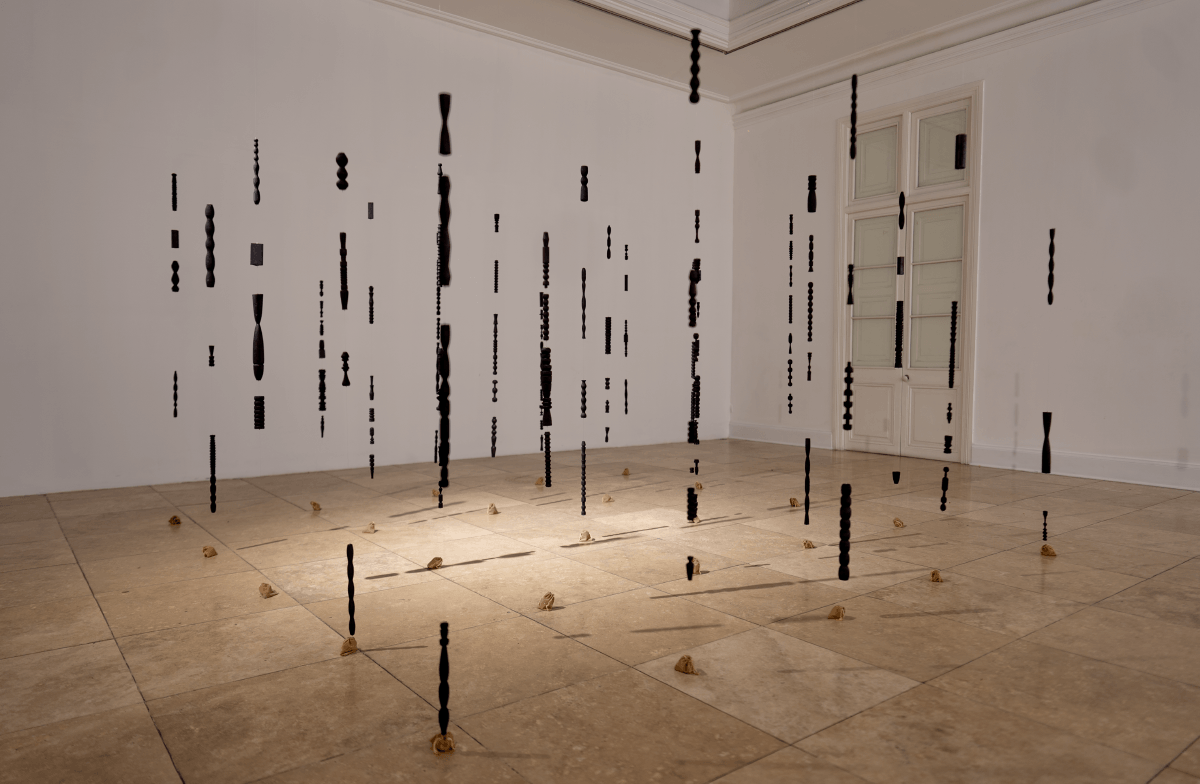
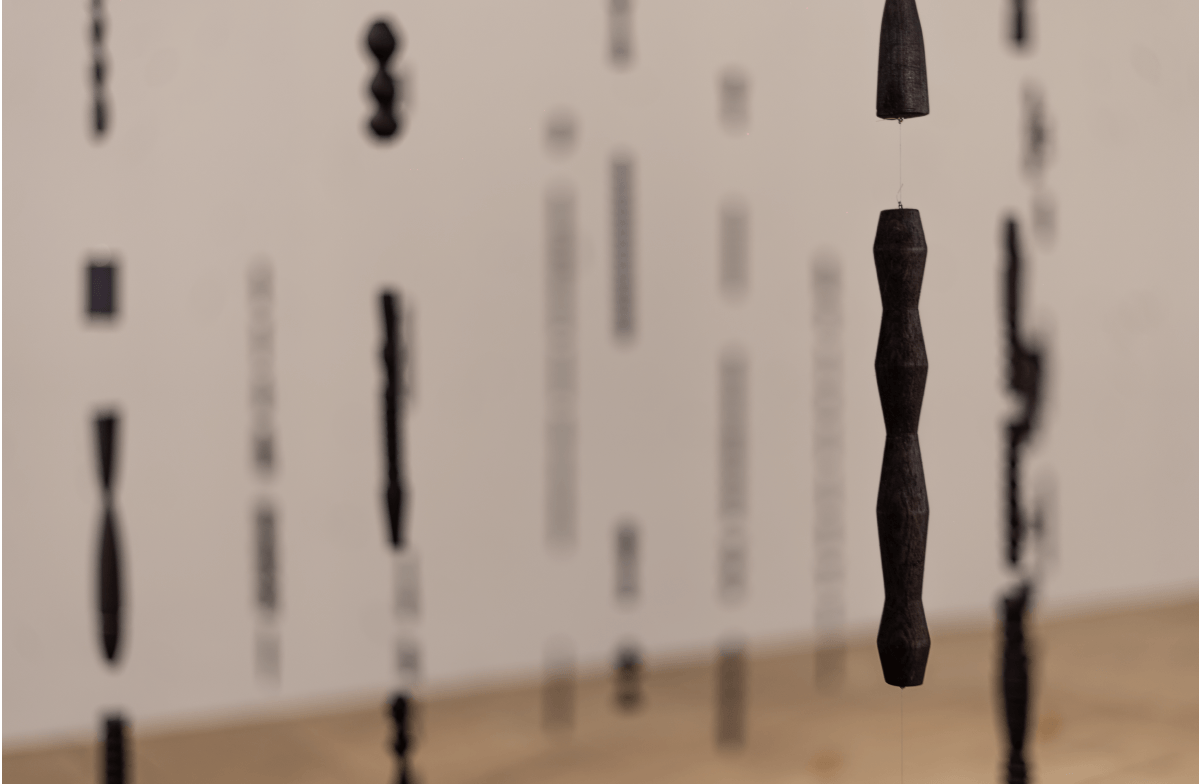
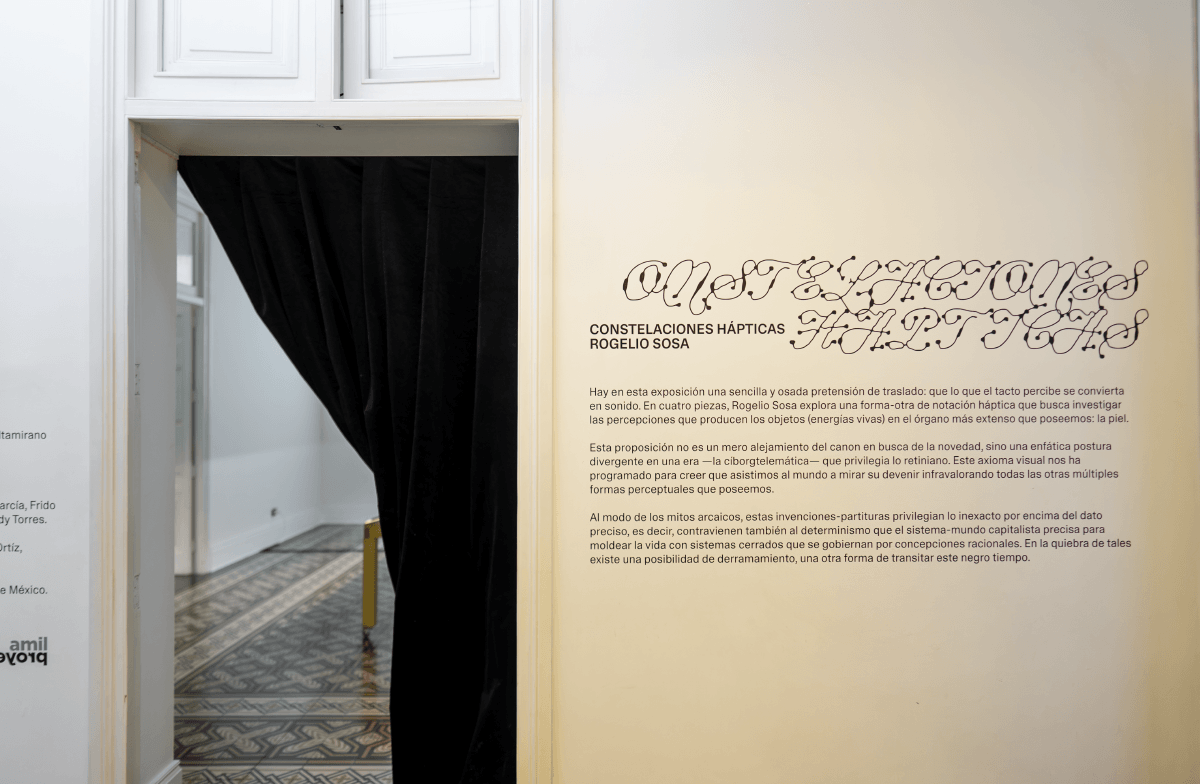
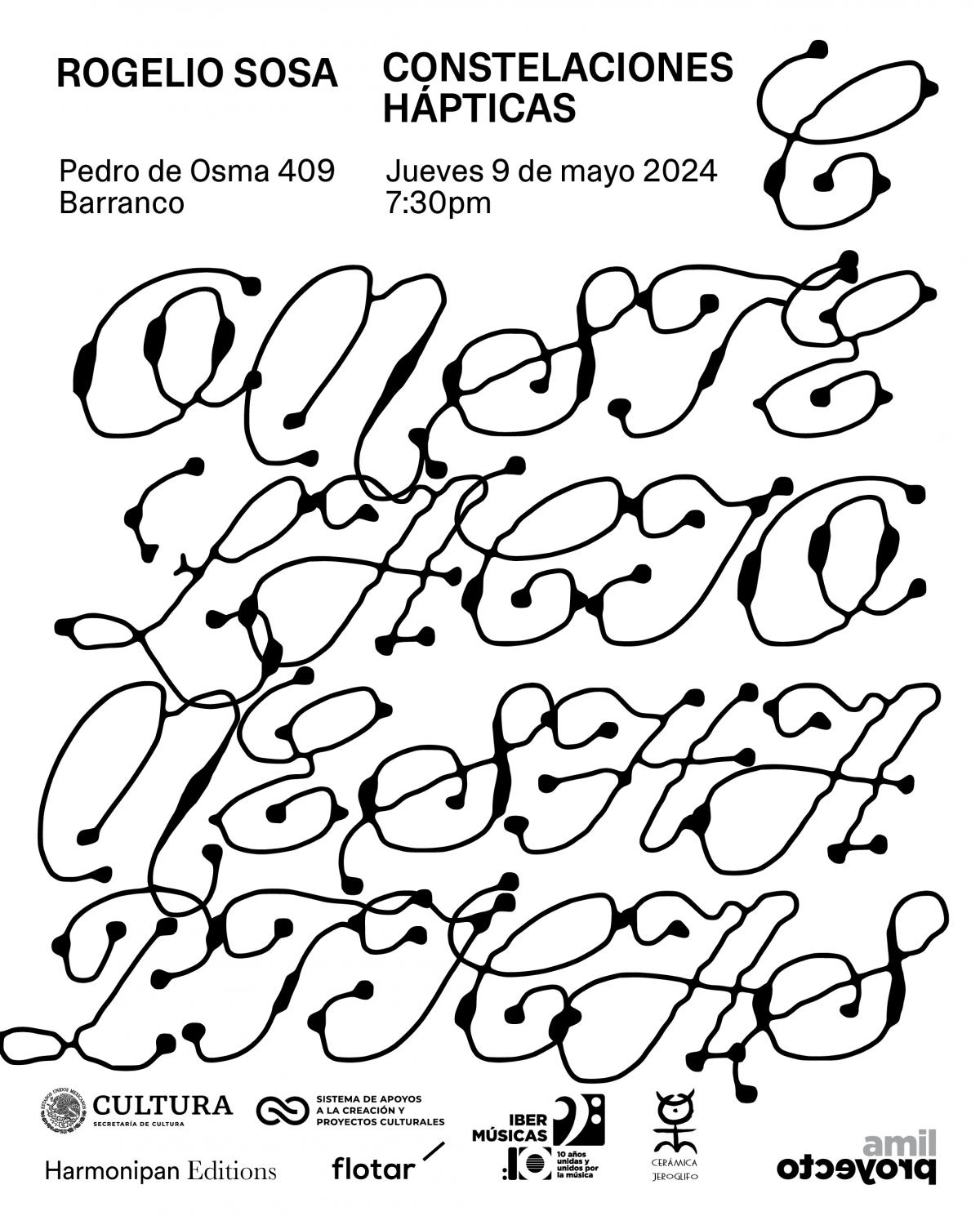
Rogelio Sosa
Constelaciones hápticas [Haptic Constellations]
Rogelio Sosa
Constelaciones Hápticas
Inauguración
Jueves 9 de mayo 2024
7:30pm
9 mayo – 31 agosto 2024
Av. Pedro de Osma 409, Barranco
Lima, Perú
Ingreso libre
Horario
Miércoles – sábados
3pm - 8pm
proyectoamil
Lima
proyectoamil se complace en presentar la primera exhibición en Lima del artista mexicano Rogelio Sosa. Esta exposición, titulada Constelaciones hápticas, muestra los resultados de la residencia que el artista ha tenido en Lima por mes y medio. Rogelio ha producido cuatro obras especialmente para nuestro nuevo espacio de Barranco.
Hay en esta exposición una sencilla y osada pretensión de traslado: que lo que el tacto percibe se convierta en sonido. A contra pelo de la tradición académica de notación musical gráfica, Rogelio Sosa explora una forma-otra de notación háptica que busca investigar las percepciones que producen los objetos (energías vivas) en el órgano más extenso que poseemos: la piel.
Esta proposición no es (solo) un divertimento, ni un mero alejamiento del canon en busca de la novedad, tan cara al sistema del arte, sino una enfática postura divergente, anti hegemónica en una era —la cíborgtelemática— que privilegia lo retiniano.
Este axioma visual nos ha programado para creer que asistimos al mundo a mirar su devenir, que vamos a una galería o a una exhibición a observar, infravalorando todas las otras múltiples formas perceptuales que poseemos. Esos blancos espacios —falsamente neutros— sirven como lugar en el que los objetos entran (asépticos) a nuestrxs cuerpos a través de la mirada: la galería es el paralelo de la página, presta para recibir el logos en su necio romance con la tinta. Ambos sistemas de exhibición y transmisión del conocimiento son una inversión de una de las mas antiguas formas de escritura: las estrellas en el cielo; constelar siempre fue escribir, hacer del cosmos un mito para pasarlo a través del tiempo.
Al modo de las arcaicas historias y de los inmemoriales mitos, las invenciones-partituras de Rogelio privilegian lo inexacto por encima del dato preciso, es decir, contravienen también a la necesaria determinación y eficiencia que el sistema-mundo capitalista precisa para conseguir sus flujos mercantiles. Esta negación de lo exacto induce un alto grado de libertad creativa al intérprete, que con la voz traduce a sonido lo que sienten sus yemas y sus palmas: texturas, rugosidades, volúmenes, topografías, similitudes, diferencias.
Las cuatro formas materiales que devienen partituras brotan del encuentro que Rogelio tuvo en Perú hace unos años con los quipus; ahora, tras decantar la fascinación, propone una abyección del objeto y su principio: más allá de entenderlos como sistema mnemotécnico de notación y conteo, Rogelio encuentra en ellos una posibilidad de escritura ambigua.
Los nudos, las maderas, las cerámicas, los relieves y los demás objetos no pretenden guardar con “exactitud”, sino convertirse en una provocación para la interpretación creativa de un sistema que explora los intersticios y los pliegues entre las dualidades para ampliar —a modo de metáfora— el infinito espectro de grises entre dos vacíos.
Estas estructuras-constelaciones de improvisación necesitan del
aguzamiento
sentir
pensar
emitir
De tal modo que el tacto afecta al simbiótico cuerpo del intérprete, que a su vez reacciona inhalando-entonando, reaccionando-sonando.
Los cuatro objetos-sistemas tienen en común su negrura. Si bien esta cualidad no es absoluta (podemos verlos ofreciendo puntuales reflejos en el espacio, o tonalidades marrones y terrestres), pretende erigirse como otra negación a la visualidad dominante: desean su ausencia, o ser un velo más que una materia-imagen. Vale repetir: piden ser sentidas con el tacto para que sus matices sutiles provoquen un encuentro mutuo: la materia toca y se deja tocar.
Esa invitación a palparlas es consecuente con una ética del hacer que para Rogelio es de seminal importancia: su trabajo implicó el modelado del barro que no se comisionó a un artesano —no hay explotación simbólica ni material—. La tierra proviene de Valle de Bravo, donde habita desde hace años procurando tejer relaciones duraderas con su entorno. Sucede igual con las láminas repujadas y con las maderas torneadas que surgen de la labor de sus manos —herramientas mediante, claramente—.
Este hacer decide conscientemente modificar ciertas materialidades que tienen una filiación orgánica como la madera, o el barro, o los textiles: guardan una estrecha relación con un territorio al que se venera y del cual se toma con cuidado, para no caer en extractivismos. Los materiales elementales ofrecen una maleabilidad superlativa y permiten “conjuntar la experiencia háptica de la manufactura con la organización de la composición y el silencio en el tiempo”, en palabras de Rogelio.
Se propone con este conjunto de obras, también, la negación de otra tendencia profusa, casi una idolatría: la afición de nuestro tiempo por lo liso, por todo aquello que no presenta asperezas ni diferencias. Pensemos en cuántas ocasiones hemos acariciado la impoluta pantalla del teléfono y cuántas la rugosa corteza de un aliso, o de un algarrobo. Pensemos en la depilación de la piel, en el botox que inyectamos para eliminar lo rugoso, en la mayoría de las esculturas de Jeff Koons o Anish Kapoor…
Las formas de las partituras de Rogelio Sosa, se sostienen en oposición-tensión con lo liso; se nutren de discontinuidades, de lo extraño, de la negatividad de lo carrujado. Son útiles, justamente, porque refutan ese vacío (silencio) de lo liso. Dar cabida a la negatividad es aceptar la complejidad de los misterios que re-crean la existencia.
Vale reconsiderar, para terminar, a las partituras no como objetos utilitarios sino como seres que nos modifican. Elvira Espejo ha dicho a propósito del acto de hilar y de tejer
“…se mira cómo los dedos sienten; se escucha tu cuerpo cómo recibe y oye el canto de los dedos; se deja que los dedos se alimenten de las texturas para poder identificar las cosas […] El sentir de las texturas, el olor de la lana, el pensar de todo el conjunto de acciones habilita al aprendizaje multidisciplinario que permite sentir que la rueca no sólo es un instrumento sino un ser vivo que te inspira y que te guía, para hacer llegar un hilo de la vida al telar.”
Esos mismos principios son, aquí, puestos en juego. Cada intérprete sostiene una conversación desde su subjetividad con los otros seres que toca y que lo modifican. O, especulando más, sirve preguntarnos en dónde terminamos, ¿por qué consideramos a nuestra piel como lo que nos separa del mundo? ¿Qué somos sino una incesante relación?
Desde hace siglos, la modernidad moldea la vida con sistemas cerrados que se gobiernan por concepciones racionales; en la quiebra de tales, existe una posibilidad de derramamiento, una otra forma de transitar este negro tiempo.
Mauricio Marcin
